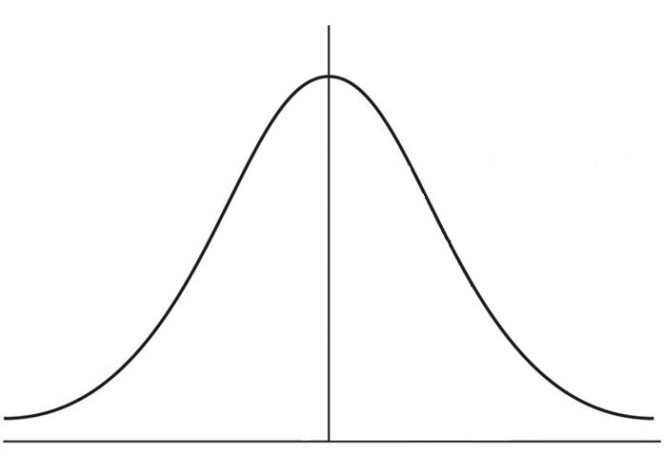
Forgive my shoddiness today. I’ve been writing about the madness that is QAnon all morning, so I didn’t get chance to sit down and write about the things I’d intended to write about. I might leave that for another post and instead write a very quick piece about the exam grade controversy that’s currently in the news. I’m no expert in education but I have some suspicions as to what’s been happening…
First, there is copious amouts of politiking going on, bad decisions being made, but also a certain degree of media hysteria surrounding the story. Zoe Williams has an interesting take on why grades are inflated (I think she’s probably correct about bias) over at The Guardian but here is mine.
The reality we’re witnessing, I think, is that people are slowly realising that you can’t beat the bell curve…

It’s really the Normal Distribution and a lot of things in nature fall on this curve which looks like a bell. The height of people is distributed normally: extremely small people and extremely tall people at either end, in the middle are most of us, around the median sizes for men and women. But it’s not just height. Nearly everything about our nature is distributed according to this curve including intelligence and… yes, you’ve guessed it… exam results.
The distribution is used to figure out what marks students get each year. It’s a way to ensure that no one year group is given better results (generally speaking) than the year before given the non-consistent nature of exam difficulty. It’s pretty obvious when you think about it. There are always a few geniuses on the right side of the curve who get the top grades. There are also those ninnies on the far left that get a U. Most people are around the middle, where you find the C grade.
So, even if one exam is particularly hard, the geniuses (or is it genii?) will get better marks that most people, whilst the poorer students will do particularly poorly. It doesn’t much matter. The whole results can then be shifted so they plot against the standard results curve. So, even if a Grade A was 90% one year, it means exactly the same as a 70% result on a particularly different paper set a different year. Numbers don’t really matter as much as where you fall on the curve.
Well, that’s the theory.
The reality is that schools are involved in political systems where money is often linked to performance. Headteachers and senior staff are under pressure to prove their school is doing well and one way they reflect this is by boosting the expected grades of students. Happens all the time across the state sector, though I doubt if you’d find many people willing to go on the record and admit it happens.
Usually, this grade inflation results in a familiar narrative. I’ll take an extreme example. Little Tommy Shufflebottom was predicted to get a grade C but he actually gets a grade F because Little Tommy was a notorious truant who spent most of his lessons asleep in the corner of the room. Teachers were expected to raise Little Tommy up to a C but most teachers know by experience that Little Tommy can’t be taught and, besides, the grading curve always needs some people to get grade F. You can’t beat the curve and you can’t beat human nature. You can dress it up as much as you like but every generation has their dolts. Nothing ever changes that.
That doesn’t change the fact that the Shufflebottoms get mightily pissed off that Little Tommy got an F and not a C. Teachers catch the shit for Tommy’s bad grades, Tommy leaves school, can’t be arsed taking the exam again (because now he’s adult and can do what he wants) and life moves on as it always has moved on. It’s a familiar cycle of education and why nobody in their right mind would go into teaching.
This year, the story is being played out across the entire grading spectrum. It’s affecting good students as well as bad, students who are being marked down because of factors that have nothing to do with them and a whole lot to do with a wildly inconsistent and acutely political system. When those grading curves are applied to the optimistic / pessimistic predicted grades produced by teachers (mainly in the state sector), we have the shocking realisation that many of those grades do not reflect reality. Yet they never did.
So, whose fault is it?
Well, part of it does come down to the weird world we’re currently experiencing, with schools and examination boards expected to do something that is impossible: guess an outcome based on a limited and unrealiable set of data. Beyond that, the blame lies with the government who have been putting too much pressure on the state school system, often through Ofsted and the threat of Academisation. Predicted grades are meant to be a practical tool to help teaching but they have become corrupted by politics of the system. I suspect this is why most of the controversy about downgrading is happening in schools in poorer areas. Better schools are simply more successful at weeding out the weaker students, meaning they won’t ever pollute their numbers. Private schools not only provide better education, in small classes, but also don’t have the same financial pressures. That means they have a better sense of their student’s ability and they don’t need to lie about Little Bartholomew, who was probably selected so it was obvious before he started that he wasn’t going to spend most of his time injecting himself with bleach (other stupid drug experiments are also available).
I’m probably overstating this a little (or, no doubt, somebody would scream “a lot”) but from what I know about teaching I don’t think my conjectures are too wild. When the guesses are corrupted by politics, how can the government convert those guesses into reasonable projections that aren’t themselves rooted in politics?
It’s why I have such cynicism about education; not because I don’t believe in it – I do, fiercely – but because I think it’s been replaced by something else, which is political, economic, and often quite notional. Nobody would want to admit that a grammar school system is better – and it’s not without its problems – but the idea of comprehensive education fails because of the reality that mixing good students with bad will usually hinder the good students whilst doing very little to help the bad. Trying to make scholars of every Little Tommy Shufflebottom is the country is doomed to failure. Politicians should wake up to that reality and started to give Little Tommy the kind of education he wants and might even enjoy. If we can be progressive enough excuse children of one faith from assemblies in another faith, why can’t we do this across the board? I ask it again and again about my own speciality: why teach low ability students Shakespeare? There is no educational reason, just one big glaring political reason which is the British identity, fetishized by the Tories. Make no mistake: Labour are subject to their own awful preoccupations, notably how “identity politics” creep into the curriculum during Labour years. The point is the same, irrespective of the government: grades don’t matter as much as the people behind those grades. Look deeper and we might actually make more of every child’s potential.


The grade inflation in A levels went hand in hand with the abysmal decision to expand the number of students in higher education during the happy clappy, everyone’s a winner, Blair years. The grade inflation in A levels and GCSE’s then spread into degrees. In the mid 90’s when I got my bachelors degree, only 27% of people went to university, only 7% of students achieved a first. That meant that when I got my first class degree, I was one of less than 2% of people from my year to do so, it was a minor achievement.
Now over 50% of young people are going to university with 28% getting firsts, that is 14% of students in any given year getting the top prize. When you look at how many students are now achieving at least a 2.1 it is up from 47% to 79%, with 13 universities awarding at least 90% of their students a 2.1 or higher. It makes it meaningless. Employers clearly agree when you look at the number of students failing to earn enough to pay back their student loans.
Stupid people have created a multi billion pound monster that is now very difficult to roll back without a government having the guts to stand up to the massed wailing of students, parents, teachers and academics. This country didn’t struggle for doctors, nurses, engineers or teachers before the expansion of higher education it wouldn’t struggle if that sector was reduced to its pre Blair size.
Letting people believe that they are something that they are not, only to have them disabused of that notion when they enter the job market is in many ways a cruel thing to do.
Another comment that’s spot on. Can’t disagree with any of that.
It’s a huge problem. The old polytechnic system worked and provided a different kind of education to the universities but just as valuable. More practical and not quite so esoteric.
But this isn’t just down to Blair — though I agree his expansion of universities was hopeless — but the Tories too. It’s a point I’ve probably made too often but, when I was young, the Tories were The Party of the Professional Classes. It meant something to be a doctor or a teacher or a lawyer… What the Tories have done and continue to do is to cheapen everything. Teachers replaced by teaching assistants, doctors replaced by nurses, police officers replaced by “cod boddies”… They reduce the time it takes to qualify to increase the number of people in a certain field. More means cheaper and it’s a process that spirals into mediocrity.
This is really the next step in the story we’re seeing at the moment – when these poor buggers get to university and realise that schools really didn’t prepare them from independent thought and study. When universities are offering degrees in “Health and Wellness” and “Hair and Makeup for Fashion” we know we’re truly fucked as a country.
But regarding these results, the much-lamented algorithm is another way to talk about the curve I mentioned yesterday. It’s really the point you make about fooling people into thinking they’re something they’re not. The government have pushed too hard, forcing teachers to try to beat the curve. The D student had to become a C student. The B become an A. It’s totally artificial. The curve is constant. Ds are always Ds… Bs are always Bs. Of course, people are capable of change but it’s exceedingly rare and requires intense mentorshop. Generally, however, the curve is the curve.
This is why the better schools aren’t being affected. They concentrate on proper teaching. The state schools are stuck with government meddling.